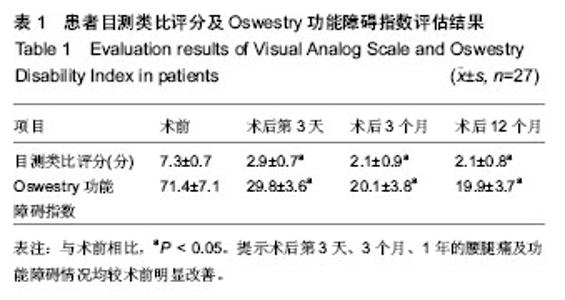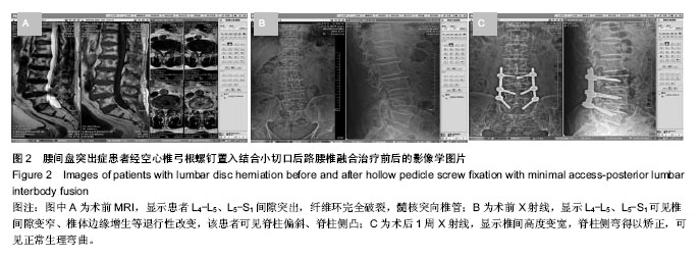| [1] Spoor AB, Oner FC. Minimally invasive spine surgery in chronic low back pain patients. J Neurosurg Sci. 2013;57(3): 203-2118.
[2] Quraishi NA, Rampersaud YR. Minimal access bilateral transforaminal lumbar interbody fusion for high-grade isthmic spondylolisthesis. Eur Spine J. 2013;22(8): 1707-1713.
[3] Cheung NK, Ferch RD, Ghahreman A,et al. Long-term follow-up of minimal-access and open posterior lumbar interbody fusion for spondylolisthesis. Neurosurgery. 2013; 72(3): 443-450; discussion 450-441.
[4] Manjila S, Singer J, Knudson K,et al. Minimally invasive presacral retrieval of a failed AxiaLIF rod implant: technical note and illustrative cases. Spine J. 2012;12(10): 940-948.
[5] Nasca RJ. Newer lumbar interbody fusion techniques. J Surg Orthop Adv. 2013;22(2): 113-117.
[6] Kepler CK, Yu AL, Gruska55y JA,et al. Comparison of open and minimally invasive techniques for posterior lumbar instrumentat6ion and fusion after open anterior lumbar interbody fusion. Spine J. 2013;13(5): 489-497.
[7] Silvestre C, Mac-Thiong JM, Hilmi R,et al. Complications and Morbidities of Mini-open Anterior Retroperitoneal Lumbar Interbody Fusion: Oblique Lumbar Interbody Fusion in 179 Patients. Asian Spine J. 2012;6(2): 89-97.
[8] Kok D, Grevitt M, Wapstra F,et al. The Memory Metal Spinal System in a Posterior Lumbar Interbody Fusion (PLIF) Procedure: A Prospective, Non-Comparative Study to Evaluate the Safety and Performance. Open Orthop J. 2012;6: 220-225.
[9] Massicotte E. The role of minimally invasive techniques in the management of spinal neoplastic disease: a review. J Neurosurg Sci. 2013;57(3): 193-201.
[10] Almenawer SA, Crevier L, Murty N,et al. Minimal access to deep intracranial lesions using a serial dilatation technique: case-series and review of brain tubular retractor systems. Neurosurg Rev. 2013;36(2): 321-329; discussion 329-330.
[11] Schwartz Z, Raz P, Zhao G, et al. Effect of micrometer-scale roughness of the surface of Ti6Al4V pedicle screws in vitro and in vivo. J Bone Joint Surg Am. 2008;90(11):2485-2498.
[12] Moon BJ, Cho BY, Choi EY, et al. Polymethylmethaerylate- augmented screw fixation for stabilization of the osteoporotic spine: a three-year follow-up of 37 patients. J Korean Neurosurg Soc. 2009;46(4):305-311.
[13] 王春,陈少坚.经皮长U形空心椎弓根钉系统治疗胸腰椎骨折的生物力学研究[J].中华创伤骨科杂志,2012,14(7):595-560.
[14] 王春,林永绥,刘清平,等. 经皮长尾可折U形空心椎弓根钉系统固定治疗胸腰椎骨折的疗效评估[J].中国脊柱脊髓杂志,2012, 22(7):627-633.
[15] Jung HJ, Kim SW, Ju CI, et al. Bone cement-augmented short segment fixation with percutaneous screws for thoracolumbar burst fractures accompanied by severe osteoporosis. J Korean Neurosurg Soc. 2012;52(4):353-358.
[16] Korovessis P, Repantis T, Petsinis G, et al. Direct reduction of thoracolumbar burst fractures by means of balloon kyphoplasty with calcium phosphate and stabilization with pedicle-screw instrumentation and fusion. Spine (Phila Pa 1976). 2008;33(4):E100-108.
[17] Lubansu A, Rynkowski M, Abeloos L, et al. Minimally invasive spinal arthrodesis in osteoporotic population using a cannulated and fenestrated augmented screw: technical description and clinical experience. Minim Invasive Surg. 2012;2012:507826.
[18] Magerl FP. Stabilization of the lower thoracic and lumbar spine with external skeletal fixation. Clin Orthop Relat Res. 1984;(189):125-141.
[19] Mathews HH, Long BH. Endoscopy assisted percutaneous anterior interbody fusion with subcutaneous suprafascial internal fixation: evolution for technique and surgical considerations.Orthop Int Ed. 1995;3:946.
[20] Foley KT, Gupta SK. Percutaneous pedicle screw fixation of the lumbar spine: preliminary clinical results. J Neurosurg. 2002; 97:7 12.
[21] Park Y, Ha JW. Comparison of one level posterior lumbar interbody fusion performed with a minimally invasive approach or a traditional open approach. Spine. 2007;32: 537-543.
[22] Kasis AG, Marshman LA, Krishna M, et al. Significantly improved outcomes with a less invasive posterior lumbar interbody fusion incorporating total facetectomy. Spine (Phila Pa 1976). 2009; 34(6):572-577.
[23] 刘瑶瑶,代飞,孙东,等. 不同量骨水泥强化新型空心椎弓根螺钉的体外生物力学研究[J]. 第三军医大学学报,2012,34(16): 1626-1629.
[24] Waits C, Burton D, McIff T. Cement augmentation of pedicle screw fixation using novel cannulated cement insertion device. Spine (Phila Pa 1976). 2009;34(14):E478-483.
[25] Pesenti S, Blondel B, Peltier E, et al. Percutaneous cement-augmented screws fixation in the fractures of the aging spine: is it the solution? Biomed Res Int. 2014;2014: 610675. |



